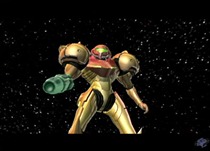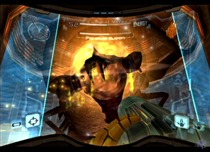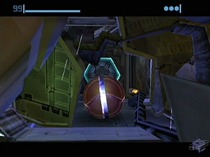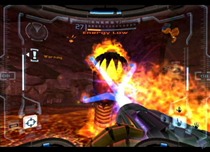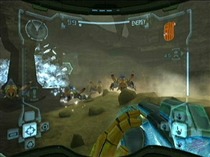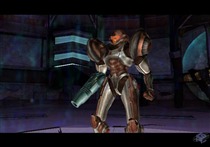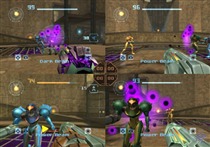We take a look back at the games worthy enough to be considered the GameCube's best.


Metroid Prime
Released November 17, 2002
Developed by Retro Studios
Published by Nintendo
Retrospective by David Trammell
The Metroid series has long been a favorite of Nintendo's most ardent fans, but it has never achieved the kind of sales figures that Nintendo's heaviest hitters have attained, perhaps due to its mature themes and significantly higher difficulty. Whatever its market limitations, Metroid fans were forced to wait eight long years after Super Metroid before receiving another dose of the prized franchise. And what a dose it turned out to be. Much to fans' surprise, and in many cases dismay, Metroid Prime turned out to be played mostly from a first-person perspective. Yet that perspective is arguably one of Prime's greatest strengths, as it allowed Retro Studios to make the game immersive on an unprecedented level.
The first glimpse of Metroid Prime was given in August of 2000 at Nintendo’s Space World event. A 10 second video clip was shown featuring Samus running from parasites in a dark, industrial-themed hallway. Nintendo had apparently axed an internal Metroid project and, just before the show, asked Retro Studios to begin converting an unfinished game into a new Metroid title. Soon after the show, Shigeru Miyamoto shockingly instructed Retro to make the game first person due to the difficulty of implementing third person shooting. Critics of the first person view were mostly silenced when the game was finally released in November of 2002. Metroid Prime went on to become the third highest ranked game of all time according to meta rating site Game Rankings.
So what makes Metroid Prime so great? This is a question not easily answered. Metroid Prime's greatness is a result of each of the game's systems working carefully together to create a powerful, unique, immersive experience. The icing on the cake is an art style and level of atmospheric detail that is endlessly interesting and applied consistently throughout the game's many environments.
The first thing many players will notice is the detailed art style. Unlike most designers who are content to let textures and basic geometry convey most of the environmental details to the player, Metroid Prime features extensive use of intricate geometry, animated surfaces, particles, and transparency in addition to standard textures to immerse the player in its world. To this visual feast, complex environmental sounds are added, including sounds created by Samus's own suit as the player performs such mundane tasks as looking around. Players quickly discover that they are truly behind the visor of Samus, as rain drops and jets of steam cloud the visor, obscuring their vision. As players progress through the game, they discover many creatures inhabiting the planet of Tallon IV that are not hostile. These details bring the game to life in a very real way.
Soon enough, most players will begin to soak up Metroid Prime's ingeniously told story by way of the scan visor. Details of enemy biology, Space Pirate machinations, Chozo lore, and environmental history are all revealed to the curious player, further increasing the game's immersiveness. The atmospheric adventure is periodically interrupted by action sequences. Intense boss fights require the player to put their increasing capabilities to the test, and morph ball puzzles make sure that no one forgets what franchise they're playing. One thing players may not notice is loading times. These were cleverly disguised using the traditional, shoot-to-open doors of the series, and infrequent elevator sequences. The game was rounded out with an addictive, although unforgiving, collecting aspect requiring the player to scan everything in the game to unlock art galleries. Additionally, a hard mode allows expert players to continue enjoying the game after the first play through.
With the possible exception of its first-person perspective, the most contentious aspect of Metroid Prime is its control scheme. Considered by many to be brilliant, and others to be the greatest blunder of all time, the scheme shucks conventional first-person wisdom and only allows the player control via a single analog stick. For many, the resulting control scheme only increased the level of immersion by making the game feel distinct from traditional first person games while ultimately sacrificing very little function. Nevertheless, many found that fully adjusting to the unusual method of control was impossible, and they were unable to enjoy Metroid Prime to its fullest (if at all). Despite this, Metroid Prime remains one of the most critically acclaimed games of all time, and undoubtedly one of the GameCube's greatest.
Thoughts From the NWR Staff
Ryan Winterhalter: "The resurrection of Metroid on the GameCube was something most thought impossible. After its announcement, the die-hard fans lamented at the fate of their once beloved side-scroller. Well, Retro not only made the critics eat crow, it made them like it. Metroid Prime is an incredible game and a must have for any GameCube library."
Karl Casteneda: "While I'm not much of an adventure buff (or any kind of buff), even I can appreciate Metroid Prime's attention to detail. It's obvious that the folks at Retro Studios really poured all of their collective experience into making this one of the most flawless 3D transitions since Super Mario 64."
Daniel Bloodworth: "Like Mario 64 and Zelda Ocarina of Time, Metroid Prime was full of these amazing moments where you got to experience aspects of the original games in 3D for the first time. Seeing familiar enemies, blowing through a wall for the first time, or finally finding the spider ball were absolutely magical moments in the game. The secrets and clever level design proved that Metroid could indeed make the transition to 3D. And it's such a visual masterpiece that it's the standard I use whenever I test out a new TV. I recently replayed Echoes in anticipation of Metroid Prime 3, but now that the Wii game has been delayed, perhaps I'll have a chance to go through the original once again."
Jonathan Metts: "Metroid Prime is a landmark game not because of its technology but because it applies a distinct, brilliant game design to a type of game (the first-person shooter) that at the time was usually associated with dumb, repetitive action scenes. Although I still have some problems with how Samus moves in 3D space, the Metroid Prime games are unquestionably incredible and have become some of my favorite games of the generation."
Michael Cole: "As odd as it may sound, Metroid Prime was my first positive experience with the series. As a younger and less experienced gamer I quickly gave up on the very difficult NES original, and I was unable to effectively navigate Super Metroid when it came out. When Metroid Prime came out, I was experienced enough to manage its complex geography and appreciate the atmosphere. Not only was Metroid Prime one of my best GameCube experiences, it gave me the courage to revisit the prior entries in the series--I am eternally grateful."
Evan Burchfield: "Metroid Prime is successful in only one way that matters: the world felt real. While solving puzzles and fighting enemies, the environment never ceased to breathe and pulse - the ecology of Talon IV was deeply entwined in the game's story and was brought to the forefront of your attention via the scan visor. Likewise, the Chozo's abandoned architecture put Samus's lonely mission in perspective and made the player experience firsthand her discovery and examination of their ancient culture. And like most Nintendo games, it communicates its plot through gameplay devices, not dialog (for better or worse)."
Jon Lindemann: "Super Metroid is one of my all-time favorite games, and one of the few that I've taken the time to play through more than once. Metroid Prime is just as good, but in 3-D. But more than its amazing graphics and gameplay, I remember Metroid Prime for providing me one of the biggest "Oh My God I'm a Game Nerd" moments of my life. I was having lunch at work, and a buddy of mine (pretty much a non-gamer) asked me how Metroid Prime was going. Without a moments hesitation I responded with, "Dude, it's awesome...I just beat this one boss that falls on top of you when he dies, and then you get the best armor in the game by getting infused with his Phazon Ore." The guy practically fell out of his chair laughing, and ever since the phrase 'Phazon Ore' has been one I've never been able to live down."
Much to the delight of Prime fans, Retro Studios immediately began work on a sequel after finishing the original. Metroid Prime 2: Echoes, released about two years after the original Prime, is a relatively straight sequel. It incrementally improves on most aspects of its predecessor and offers new gameplay experiences via its prevalent light/dark theme. Echoes has a reputation for having more interesting boss fights and far better use of the morph ball feature than seen in the first game. On the other hand, half of the MP2 takes place in the alternate dark version of the planet Aether. Consequently, nearly half of the game's macro geometry is borrowed from the light half of the game, and the dark half always features the same gray and purple color tones, which start to wear thin in time. Additionally, transitioning to the dark world introduced much more noticeable loading times, particularly in the few areas where the player was required to travel back and forth repeatedly. The inclusion of an out-of-place multiplayer mode further added to the obscurity of Prime 2.
Overall, the original remains the definitive starting point for new comers to the series. Even so, the fundamental elements of Metroid Prime remain apparent in Echoes, making it another milestone in GameCube history.

